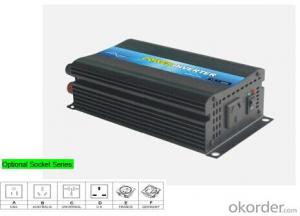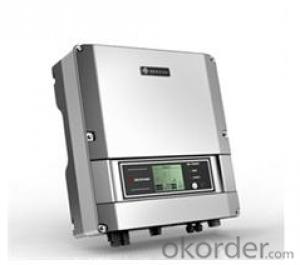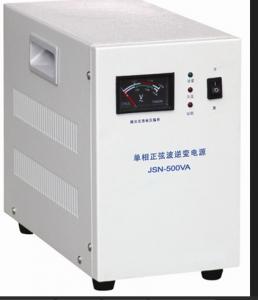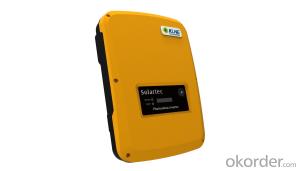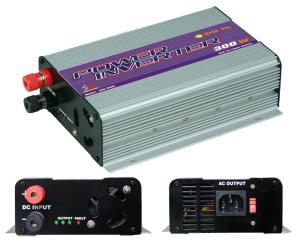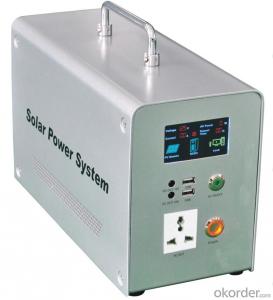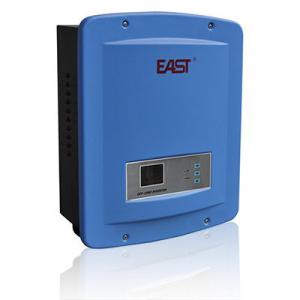300W Off-Grid Solar Inverter - Solar Inverter Italy
- Loading Port:
- China Main Port
- Payment Terms:
- TT OR LC
- Min Order Qty:
- -
- Supply Capability:
- -
OKorder Service Pledge
OKorder Financial Service
You Might Also Like
Features
Pure sine wave output (THD<3%)
Power ON-OFF switch
Input voltage range:-20% ~ +30%
Output voltage regulation:±10%
Thermo control cooling fan
Two-color indicators display power and fault status
Protections:short circuit, overload, over temperature,
Low battery voltage, over battery voltage, lack-voltage alarm.
Topology: Pull-push
Approvals: CE mark / EMC / LVD/ RoHS
1 year warranty (Remarks: Customizable input voltage such as 36v, 72v, 96v,110v;output voltage such as 120v, 130v, 200v,240v, etc; )
Order model No | P300w-12A | P3000w-24A | P300w-48A | P300w-12B | P3000w-24B | P300W-48B | ||||||
Output | AC voltage | 110V±10% | 220V±10% | |||||||||
Rated power | 300W | 300W | ||||||||||
Peak power | 600W | 600W | ||||||||||
Waveform (THD) | Pure sine wave (<3%) | Pure sine wave (<3%) | ||||||||||
Frequency | 60Hz ±0.3% or 50Hz ±0.3% | |||||||||||
Input | NO load current draw | <0.34A | <0.32A | <0.2A | <0.34A | <0.32A | <0.2A | |||||
DC voltage | 12V | 24V | 48V | 12V | 24V | 48V | ||||||
DC Voltage range | 9.5~16V | 19~32V | 38~63V | 9.5~16V | 19~32V | 38~63V | ||||||
Efficiency | > 86 % | > 88 % | > 90% | > 86 % | > 88 % | > 90 % | ||||||
DC connector | Cables With Clips or Car Adaptor | Cables With Clips or Car Adaptor | ||||||||||
Protection | DCLow voltage alarm | 10.3~10.6V | 20.6V ~21.2V | 41.2V~42.4V | 10.3~10.6V | 20.6V ~21.2V | 41.2V~42.4V | |||||
DC Low voltage shut down | 9.4~9.6V | 18.8~19.2V | 37.6~38.4V | 9.4~9.6V | 18.8~19.2V | 37.6~38.4V | ||||||
Over load | Shut Off Output | Shut Off Output | ||||||||||
DC Over voltage shut down | 15.8~16.2V | 30~32V | 60~63V | 15.8~16.2V | 30~32V | 60~63V | ||||||
Over thermal | Shut Off Output Automatically | Shut Off Output Automatically | ||||||||||
Fuses | Short Circuit | Short Circuit | ||||||||||
Environment | Working temperature | -10°c ~ +50°c | -10°c ~ +50°c | |||||||||
Working humidity | 10%~90%RH | 10%~90%RH | ||||||||||
Storage temperature | -20°c ~ +50°c | -20°c ~ +50°c | ||||||||||
Work altitude | ≤1000m | |||||||||||
Package | Machine Size(mm) | 220*118*63 | 220*118*63 | |||||||||
Packing Size(mm) | 250*120*66 | 250*120*66 | ||||||||||
Net Weight | 1.3kg/unit | 1.3kg/unit | ||||||||||
Gross Weight | 1.4kg/unit | 1.4kg/unit | ||||||||||
Packing Mode | Carton | Carton | ||||||||||
Other | Star | Soft Star | Soft Start | |||||||||
Cooling Ways | Cooling Fan | Cooling Fan | ||||||||||
- Q: Can a solar inverter be used with different types of solar panels?
- Yes, a solar inverter can be used with different types of solar panels as long as the voltage and current specifications of the panels are compatible with the inverter.
- Q: Can a solar inverter be used with different types of solar cell technologies?
- Yes, a solar inverter can be used with different types of solar cell technologies as long as the voltage and current outputs of the solar cells are compatible with the inverter's input requirements. The inverter's function is to convert the DC (direct current) generated by the solar cells into AC (alternating current) that can be used by household appliances or fed into the grid. Therefore, as long as the solar cells can produce DC power within the inverter's input limitations, different types of solar cell technologies can be used with the inverter.
- Q: How does a solar inverter handle voltage phase imbalance in the grid?
- A solar inverter handles voltage phase imbalance in the grid by continuously monitoring the grid voltage and adjusting its internal control algorithms accordingly. This allows the inverter to dynamically balance the output between the phases, compensating for any phase imbalances in the grid. By doing so, the solar inverter ensures that the electricity it generates and feeds into the grid is well synchronized with the grid's voltage and phase, minimizing any adverse effects of phase imbalance.
- Q: What is the difference between a transformerless inverter and a transformer-based inverter?
- A transformerless inverter does not include a transformer in its design, while a transformer-based inverter incorporates a transformer as an integral component. The main difference lies in their electrical isolation capabilities and overall system efficiency. Transformerless inverters use circuitry to achieve electrical isolation, which can result in higher efficiency and reduced size. On the other hand, transformer-based inverters employ a physical transformer for isolation, which offers better safety and protection against electrical noise and voltage fluctuations.
- Q: How does a solar inverter handle voltage fluctuations from the solar panels?
- A solar inverter handles voltage fluctuations from the solar panels by employing a technique called Maximum Power Point Tracking (MPPT). The MPPT algorithm continuously monitors the voltage and current output of the solar panels and adjusts the operating point to ensure maximum power transfer. This allows the inverter to adapt to varying sunlight intensity and temperature conditions, efficiently converting the DC power generated by the panels into standard AC power. The inverter also incorporates voltage regulation and protection mechanisms to ensure stable and safe operation despite any voltage fluctuations.
- Q: How do you calculate the maximum power point tracking efficiency for a solar inverter?
- To calculate the maximum power point tracking (MPPT) efficiency for a solar inverter, you need to compare the actual power output of the inverter with the maximum power point (MPP) of the solar panel. It can be calculated by dividing the actual power output by the MPP power and then multiplying the result by 100 to get the efficiency in percentage. The formula is: MPPT efficiency = (Actual Power Output / MPP Power) * 100.
- Q: How does a solar inverter handle variations in AC load demand?
- A solar inverter handles variations in AC load demand by constantly monitoring the load and adjusting the output power accordingly. It uses advanced control algorithms to regulate the voltage and frequency of the AC output to match the specific requirements of the connected devices. This allows the inverter to effectively handle fluctuations in load demand and ensure a stable power supply.
- Q: What is the role of a solar inverter in a grid-tied system?
- The role of a solar inverter in a grid-tied system is to convert the direct current (DC) electricity produced by the solar panels into alternating current (AC) electricity that can be used by the electrical grid or consumed by the appliances and devices in a home or business. It also ensures that the solar energy generated is synchronized with the grid's voltage and frequency to enable efficient and safe transfer of power. Additionally, the solar inverter monitors and controls the flow of electricity between the solar panels, the grid, and any energy storage systems that may be connected to the system.
- Q: Can a solar inverter be used with a solar-powered vehicle?
- Yes, a solar inverter can be used with a solar-powered vehicle. A solar inverter is used to convert the direct current (DC) produced by solar panels into alternating current (AC) that can be used to power various electrical components of a vehicle. In a solar-powered vehicle, the solar panels generate DC electricity, which is then converted by the solar inverter into AC electricity to charge the vehicle's battery or power its electrical systems.
- Q: How does the quality of the AC waveform affect the performance of a solar inverter?
- The quality of the AC waveform directly affects the performance of a solar inverter. A clean and stable waveform is essential for efficient and reliable operation of the inverter. Any deviations, distortions, or harmonics in the waveform can lead to increased power losses, reduced conversion efficiency, and potential damage to the inverter. Therefore, a high-quality AC waveform is crucial for optimal performance and maximum power output from a solar inverter.
Send your message to us
300W Off-Grid Solar Inverter - Solar Inverter Italy
- Loading Port:
- China Main Port
- Payment Terms:
- TT OR LC
- Min Order Qty:
- -
- Supply Capability:
- -
OKorder Service Pledge
OKorder Financial Service
Similar products
Hot products
Hot Searches
Related keywords
